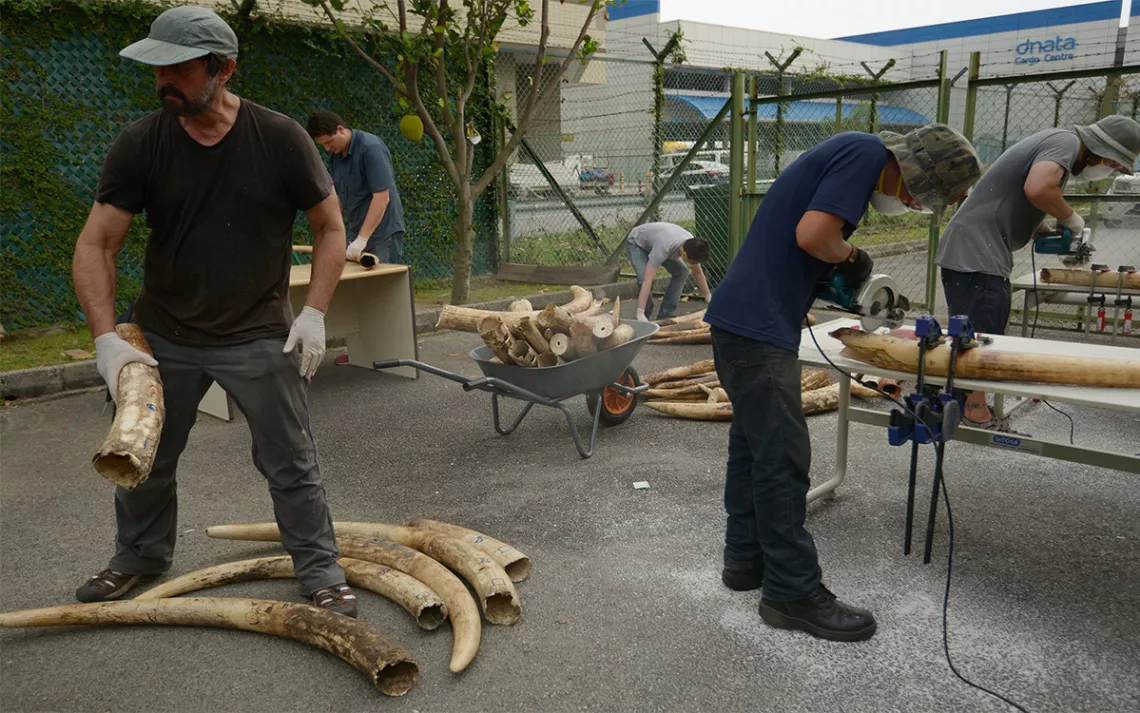Three Criminal Cartels Responsible for Most of Ivory Trafficking in Africa
Investigators link ivory seizures and trace them back to specific gangs

Dr. Samuel Wasser and his team do forensic analysis of a 4.6-ton ivory seizure in Singapore. | Photo courtesy of Kate Brooks/The Last Animals
In 2016, a Kenyan court sentenced Feisal Mohamed Ali—one of the most wanted ivory traffickers in the world at the time—to 20 years in jail. Conservationists celebrated the ruling, calling it “justice for elephants.”
Now, after serving just a few years of his sentence, Feisal has been acquitted on the grounds of trial irregularities and constitutional concerns.
But thanks to a new genetic breakthrough, in his retrial, Feisal could face steeper accusations and more compelling evidence of wrongdoing. As reported this week in Science Advances, a new forensic tool can genetically link seemingly disparate, isolated shipments of seized ivory, and by doing so reveal the extent of specific cartels’ involvement in the illegal trade. So while Feisal originally faced charges related to a single, 4,700-pound stash of ivory, he may now have to defend himself against multiple ivory-related charges.
“Our hope is that the data presented in this paper and by others can help strengthen the case against this cartel by tying Feisal and his co-conspirators to multiple large ivory seizures,” says Samuel Wasser, director of the Center for Conservation Biology at the University of Washington, who led the research. “Linking these seizures together provides a road map to follow the money and hopefully to build a much stronger case.”
Wasser first became familiar with Feisal's case when he provided evidence to the Kenyan prosecution team of the geographic origin of the ivory seized in Feisal’s possession. That insight was made possible by a prior breakthrough method Wasser and his colleagues developed, described in a 2015 Science paper. By genetically analyzing representative samples taken from large seizures of ivory, he and his team were able to trace the samples to distinct populations of elephants. This allowed them to determine where the animals were poached—even though their tusks may have shown up in a shipping container hundreds or thousands of miles away.
Wasser found that elephant poaching was concentrated in two hot spots—Tanzania and northern Mozambique, and the corner of Central Africa where Gabon, Congo-Brazzaville, Cameroon, and the Central African Republic converge—and that those poaching hubs remained more or less static over a decade. But the 2015 findings provided little information about how many major ivory cartels operate in Africa, and whether they directly support poachers in the field or buy their contraband opportunistically.
The new method helps to answer those questions. The idea for it first struck Wasser when he noticed an anomaly in the ivory samples he was sorting for analysis: Over half the tusks contained in large seizures lacked their pair. Curiosity piqued, he decided to compare genotypes among all ivory samples in his database. He found a high number of matches among seizures made between 2011 and 2014, peak years for poaching.
Of the 23 seizures from that time, Wasser and his colleagues found 26 genetically identical pairs among 11 different seizures. What’s more, the matches were sent out of the same port nearly always within 10 months of each other, and the origin of the tusks featured a high degree of geographic overlap. Collectively, this suggests that the same cartel was probably responsible for both shipments. The findings also imply that cartels likely have direct links to poachers and that the ivory they source gets purchased by middlemen who consolidate and move it up the criminal chain for export.
Based on the analysis, Wasser and his colleagues identified three major cartels responsible for much of the ivory trafficking out of Africa: one in Mombasa, Kenya (substantial evidence indicates this is Feisal’s group); another in Lomé, Togo (likely led by convicted trafficker Emile N’bouke); and a third in Entebbe, Uganda. Wasser hopes the findings will not only help build the prosecution’s case for Feisal’s upcoming trial, but also assist in securing serious convictions for a number of other criminals still at large across the continent.
The new method is solid and well-researched—and very much needed, says Thure Cerling, a geologist at the University of Utah who works on ivory issues but was not involved in the study. “Linking different seizures to related sources and individuals will be incredibly useful for law enforcement agencies,” Cerling says.
Already, this is proving to be the case, says John Brown, a special agent in the U.S. Department of Homeland Security and country representative in Kenya for Homeland Security Investigations. “The direct collaboration between our investigations and Dr. Wasser’s lab has led to the identification of multiple major transnational criminal organizations and operative cells located across the African continent and throughout Southeast Asia,” Brown says. “DNA analysis helps us focus our investigative and conservation efforts on the ground and to attack the problem at the source.”
But while the findings coming out of Wasser’s lab have proven an asset, the method has yet to be applied to its full potential in the field. This is largely because of a sampling bottleneck, Wasser says. In 2013, delegates of the Convention on the International Trade of Endangered Species of Wild Fauna and Flora unanimously voted that countries making large ivory seizures must turn over samples for origin analysis within 90 days. But, according to Wasser, hardly any complied with that directive. Various factors likely explain this, including politics, corruption, restrictive legislation, logistical confusion, and simple laziness.
By publishing and promoting these latest findings, Wasser hopes to convey to reluctant countries how critical their participation is for successful law enforcement across Africa and Asia.
“These are transnational crimes—it’s much more than one country involved,” he says. “If countries don’t collaborate to get a handle on this problem, the criminals are really going to beat us.”
 The Magazine of The Sierra Club
The Magazine of The Sierra Club



